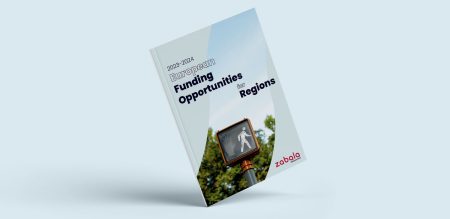
Opinion
Regions
The year of Interreg

Javier Lahuerta
European Projects Consultant
Regions
Everything you need to consider when drawing up an interregional cooperation project that is up to the standards of this programme


Regions and Cities Knowledge Area Leader
To improve the implementation of regional development policies by promoting the exchange of experiences and capacity building through the identification, exchange, and transfer of good practices between the main actors involved in the elaboration and implementation of regional policy instruments. This is the main objective of the EU’s Interreg Europe sub-programme under the European Territorial Cooperation Programme, better known as Interreg, one of the key instruments supporting cross-border cooperation through project funding.
When shaping the partnership of an Interreg Europe interregional cooperation project and determining the policy instrument to be enhanced by its implementation and operation, some key aspects need to be considered.
First, we need to know what kind of entities part of the consortium can be. Interreg Europe is the cooperation programme par excellence for the authorities responsible for regional development policy instruments, so the beneficiary entities may be:
Secondly, we need to determine their role in the partnership. Since Policy responsible authorities (PAR) are the main target group of Interreg Europe, their direct involvement is key for the cooperation project to achieve its aims. They may enter as:
The participation of policy authorities as a partner is mandatory for at least half of the policy instruments addressed. For any other policy instrument, where the responsible authority could not be available to be involved as a partner, it must participate as a partner. In this case, it is important to underline that, for the proposal evaluation process, not only the inclusion of the policy authority as a partner will be considered, but also the political relevance of the relevant partner and its capacity to influence the policy instrument addressed will be assessed.
It should also be noted that the partnership must be represented by at least one partner from each of the following geographical areas.
To talk about the responsible authority is also to consider the policy instrument it deals with, so they are two relevant and inseparable aspects of Interreg Europe projects. They cannot be separated when it comes to shaping the partnership and determining what kind of policy instrument, we want to address with the cooperation project.
The terms policy instrument or regional development policy refer to any policy, strategy or law developed by public authorities and implemented on the ground to improve a specific territorial situation. Here are just three of the many possible examples.
Once we have formed the partnership and defined the policy instruments to be addressed, we must take the last step to elaborate our interregional cooperation project: identifying the topic (topic in the language of EU funding programmes), i.e., the challenge shared by all participating regions. This could be, for example, the slow penetration of digital technologies in SMEs in a specific sector, the difficulties in preventing flood disasters in rural areas, the insufficient development of renewable energies, or the lack of integration of disadvantaged groups in the labour market.
An interregional cooperation project makes use of the experiences gained between the participating regions. Through the exchange of experiences and best practices, they will work together to identify innovative solutions with the aim of integrating them into their development policies.
In the framework of Interreg Europe, good practice is understood as any initiative related to development policies that has proven to be successful in one region and is transferable to other regions. It is successful when it has generated tangible and measurable results in achieving a specific objective. In this programme, however, it is understood that lessons learned from failed experiences can also be considered.
The question arises as to how the participating regions can conduct the process of exchange of experience and good practice, learning and knowledge transfer. The activities of an interregional cooperation project will be implemented in two phases:
Endowed with 8,050 million euros for the period 2021-2027, Interreg seeks to jointly address familiar challenges and find shared solutions in fields such as health, the environment, research, education, transport, and sustainable energy, among others. It is one of the objectives of the EU’s Cohesion Policy and is financed by the European Regional Development Fund (ERDF).
Beyond Interreg Europe, in Zabala Innovation we have a long and successful experience in the management of European projects in the framework of other Interreg funding programmes (such as Poctep, Atlantic and Sudoe) or Horizon Europe, Innovation Fund and LIFE, among others. In addition, we have first-hand knowledge of the needs and barriers faced by Public Administrations when looking for funding sources, so we can bring together the best of both worlds.
These and other funding opportunities can be found in our guide Funding Opportunities for Regions 2023-2024.

Seville Office
Regions and Cities Knowledge Area Leader

Opinion
Regions

Javier Lahuerta
European Projects Consultant

Opinion
CULTURE

Leire Martiarena
Social Innovation Knowledge Area Leader

Opinion
HORIZON EUROPE

Aritz Goñi
Leader of the International Tenders and Third Countries Area

News
REGIONS4CLIMATE PROJECT
Zabala Innovation will be part of the 44-partner consortium that seeks to measure resilience to climate change

Opinion
Regions

Javier Lahuerta
European Projects Consultant

Publication
Regions
Innovation is key to making regions more digital and sustainable, and in our publication you will learn about the funding opportunities that make this possible
The important thing is not to keep moving, but rather to know in which direction to go. Our 37% success rate proves that we know how to guide our clients.
This website uses cookies so that we can provide you with the best user experience possible. Cookie information is stored in your browser and performs functions such as recognising you when you return to our website and helping our team to understand which sections of the website you find most interesting and useful.
Strictly Necessary Cookie should be enabled at all times so that we can save your preferences for cookie settings.
This website uses Google Analytics to collect anonymous information such as the number of visitors to the site, and the most popular pages.
Keeping this cookie enabled helps us to improve our website.
Please enable Strictly Necessary Cookies first so that we can save your preferences!
This website uses the following additional cookies:
(List the cookies that you are using on the website here.)
Please enable Strictly Necessary Cookies first so that we can save your preferences!